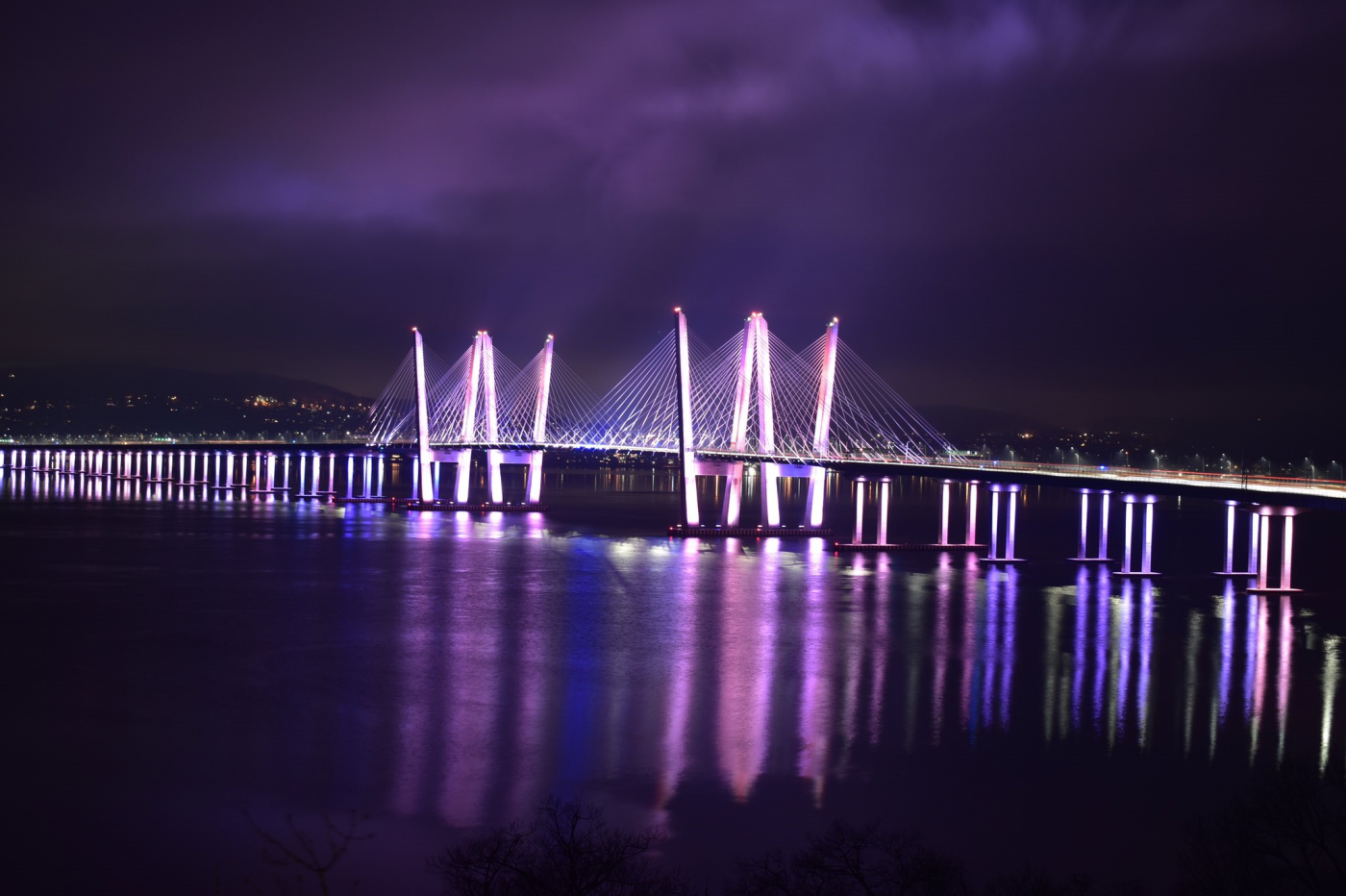Pink, Green, Blue and Purple Lights Illuminated World for Rare Disease Day

Governor Mario M. Cuomo Bridge lit up for Rare Disease Day. (Photo courtesy of the New York State Thruway Authority)
Many diseases have their own awareness color — breast cancer is pink, muscular dystrophy is green, and AIDS is red, for example — but what’s the significance of pink, green, blue, and purple lights?
These are the colors most often used to represent Rare Disease Day. This year, hundreds of buildings, landmarks, and monuments around the globe were lit up in the unique combination of colors on and around Feb. 28 to help bring awareness to this diverse group of disorders, which affect about 300 million people worldwide.
Nonprofit organizations and businesses took charge of lighting up landmarks in their respective countries under the umbrella of EURORDIS-Rare Diseases Europe. The National Organization for Rare Disorders (NORD), for example, sponsored the U.S. initiative through its Light Up for Rare campaign.
“Seeing all those monuments illuminated for Rare Disease Day underscores that rare disease patients are not alone and by coming together we can do so much more to shine a light on rare diseases, uncover new treatments and improve access to equitable care,” Lesli Nordstrom, NORD’s director of marketing and communications, said in an email to Bionews Services, publisher of this website.
4⃣5⃣0⃣ buildings and monuments worldwide lit up for #RareDiseaseDay. This is 3 times more than reported yesterday!
Thank you for your support and participation in this global chain of lights! Together we prove, once again, that…
Rare is many. Rare is strong. Rare is proud. pic.twitter.com/PBJKNcLgZu
— EURORDIS-Rare Diseases Europe (@eurordis) February 28, 2021
The official tally from EURORDIS showed at least 450 buildings and monuments bathed in the colored lights, though more participated without reporting to the organization, making it hard to land on an exact number.
NORD created the concept in 2019 with the help of Rocket Pharmaceuticals when a request from the company lit up the Empire State Building in New York in rare disease colors.
“The beautiful thing was we got messages from all over the world on Facebook and different social media that these patients from around the world felt like Empire State Building was recognizing the struggles they go through day by day,” said Kinnari Patel, Rocket Pharma president and chief operating officer, in a video interview with NORD. “In this one moment, they felt they were supported.”
This year marked the first time NORD provided support for advocates interested in lighting up community landmarks through the Light Up for Rare initiative.
Light Up for Rare is aimed at using the power of social media and grassroots advocacy to reach people virtually regardless of their connection to a rare disease. The initiative is part of the Show Your Stripes campaign, launched by NORD in 2019, with the goal of having patients “display their support and raise awareness for Rare Disease Day,” Pamela K. Gavin, NORD’s chief strategy officer, said in the video.
While NORD did not directly sponsor any Light Up for Rare buildings, the organization advertised it as part of its Show Your Stripes campaign and encouraged people affected by rare diseases to pledge a location, complete application forms to light up the public building, and share photos on social media.
One such rare disease advocate is Pam Judge, who started the Connor B. Judge Foundation that raises awareness for neuromyelitis optica spectrum disorder. Judge successfully got the Rock and Roll Hall of Fame and Tower City Center in Cleveland, Ohio, to show Rare Disease Day colors.
It was quite easy to get both of the Cleveland landmarks lit up, Judge said in a phone interview with Bionews. She had to fill out a form and be affiliated with a national foundation, such as NORD. The only difficulty was finding out where to access the forms, she said.
The impact for Judge, however, was substantial.
“All of the rare diseases separately, we can’t really move policy, we can’t move the pharmaceutical companies,” Judge said. “But together, under a large umbrella that fights for us, we can all move things quicker.”
In the U.S., landmarks such as the MetLife Stadium in New Jersey, the National Institutes of Health Building 1 in Bethesda, Maryland, and the Gov. Mario M. Cuomo Bridge in New York all were sporting lights in Rare Disease Day hues this year, along with the Empire State Building.
Tonight we illuminate MetLife Stadium in recognition of #rarediseaseday and the 30 million Americans affected by rare disorders. #LightUpForRare #HearRareRoar pic.twitter.com/oqllh8ElXk
— MetLife Stadium (@MetLifeStadium) March 1, 2021
Illuminating tonight in support of people with rare diseases for #RareDiseaseDay. #ShowYourStripes
@Rarediseases pic.twitter.com/bgYA9sfeZH— Gov. Mario M. Cuomo Bridge (@GMMCB) February 28, 2021
Worldwide points of interest, including the Leaning Tower of Pisa in Italy, the CN Tower in Toronto, the Nkrumah Mausoleum in Ghana, and the Hylton Castle in the U.K. also had lights aplenty featuring the official Rare Disease Day colors.
Rare Disease Day was created by EURORDIS in 2008 on the rare leap day of Feb. 29. In the past 13 years, the worldwide rare disease community has used the last day of February as a chance to bring awareness to the challenges of living with a rare disease and the lack of available treatments.






